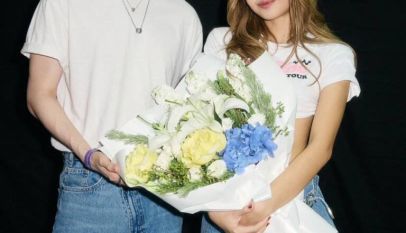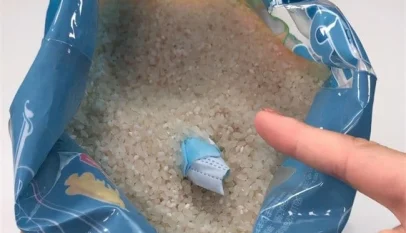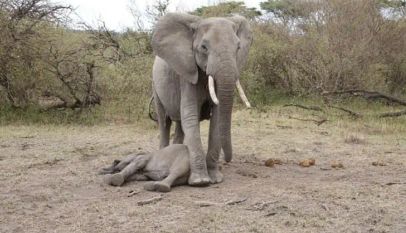
The sun had just broken over the horizon, painting the plains of Kenya in soft gold.
The air was still cool, heavy with the scent of earth and acacia.
And somewhere in the tall grass, a cry broke the silence — sharp, desperate, filled with pain.
Rangers followed the sound through the brush until they found her.
A young elephant calf, limping, trembling, her wide eyes glistening with confusion and fear.
A steel wire was wrapped tightly around her front leg, biting so deep it had reached nearly to the bone.
Each step sent waves of agony through her small frame.
Beside her stood her mother.
Huge, powerful, and utterly helpless.
Her trunk brushed against the calf’s wound, again and again, as if trying to soothe a pain she couldn’t understand.
The wire trap — set by poachers for smaller animals — had caught something far more innocent.

The rangers radioed for help.
There was no time to lose.
The Sheldrick Wildlife Trust and Kenya Wildlife Service responded immediately.
Within minutes, a helicopter thundered across the open sky, carrying veterinarian Dr. Poghon and a rescue team.
From above, the scene was heartbreaking.
The mother circled her calf protectively, ears spread wide, warning anyone who dared to come close.
Her fear was primal — the kind that only a mother knows.
But the rescuers also knew: to save the calf, they would first have to calm the mother.
Dr. Poghon prepared the dart gun, his movements steady despite the rushing wind.
With careful aim, he fired a single shot.
The tranquilizer struck, and within moments, the giant mother staggered, then slowly sank to her knees.
Her eyes fluttered but stayed open, never leaving her baby.
Even in sedation, she seemed to be watching.
The team rushed in.
The young elephant trembled, her trunk flailing weakly as they approached.
She was exhausted, her strength nearly gone.
But her spirit — like her mother’s — refused to break.
“Easy, little one,” a ranger whispered.
Their voices were soft, calm, as they worked.
Gloved hands cut through the cruel wire, freeing it from her torn flesh.
The smell of blood and infection filled the air.
Dr. Poghon crouched beside her, eyes focused, hands moving with precision.
They cleaned the wound, washed away the dirt and blood, and injected antibiotics to fight infection.
Then, they covered the open gash with healing green clay — a traditional treatment known for its natural antiseptic power.
Every touch was deliberate, gentle, as though the team understood they weren’t just saving a life — they were saving a bond.
When the treatment was done, they wrapped the wound and carried the calf uphill, where her mother lay resting.
The helicopter’s rotors had gone silent now.
The world felt still — as if even nature itself was holding its breath.
The calf’s breathing steadied.
Her trunk reached forward, seeking the warmth she had known since birth.
And there it was — her mother’s scent, faint but familiar.
They placed her beside the sleeping giant.
Minutes later, the sedative began to wear off.
The mother stirred, her ears twitching, her body shuddering back to life.
When her eyes opened fully, they landed on the calf.
A low rumble — deep, trembling, full of emotion — rolled through the clearing.
It was the sound of recognition.
Of relief.
Of love that refused to be broken.
The calf lifted her head weakly, then pressed against her mother’s side.
Two lives reunited, two hearts beating in unison once more.
The rangers stood back, silent, some with tears in their eyes.
They had witnessed countless rescues before — but this one felt different.
It wasn’t just about saving an animal.
It was about restoring something sacred.
The mother slowly rose, careful not to jostle her injured calf.
Her trunk brushed over the wound, this time not in panic, but in tenderness.
Together, they turned toward the forest.
The rangers watched as they disappeared into the green — step by step, side by side.
The calf limped, but she moved forward, guided by her mother’s shadow.
When they were gone, silence returned to the savannah.
Only the faint marks of footprints and clay remained — traces of pain, healing, and hope.
They named her Hope.
Because that’s what she had carried through every moment of fear and pain.
Hope in her own will to live.
Hope in the compassion of strangers who came to her aid.
Hope in the bond between a mother and her child that not even a snare could sever.
Word of her rescue spread quickly.
Across Kenya and beyond, people shared the story — not just of a baby elephant, but of what happens when humanity chooses kindness.
Dr. Poghon later said, “In that moment, as she stood again beside her mother, it wasn’t just a rescue — it was a reminder. A reminder of why we do this.”
For the Sheldrick Wildlife Trust and Kenya Wildlife Service, the mission continues.
Each day brings new challenges — poachers’ traps, shrinking habitats, fractured herds.
But stories like Hope’s fuel their determination.
They remind the world that even in places where cruelty hides in the shadows, compassion can rise stronger.
Somewhere in the wild heart of Kenya, as the sun sets over the acacia trees, a small elephant walks beside her mother.
The wound has begun to heal.
The pain has faded into memory.
And though she still limps slightly, she walks with purpose — toward life, toward freedom, toward tomorrow.
🌿
Because in that dawn of rescue, she was given not just her life back — but her name.
Hope.






